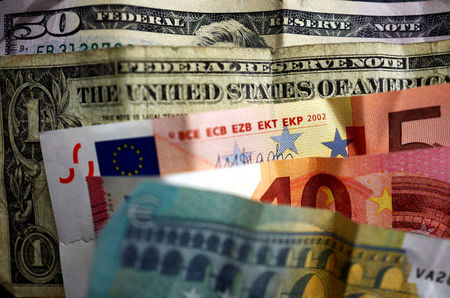Forex
Dollar edges higher on Trump ascendancy; ECB meeting looms

Investing.com – The U.S. dollar edged higher in early European trade Tuesday, climbing away from one-month lows as traders digested the increased chance of former President Donald Trump returning to the White House as well as the likelihood that the Federal Reserve will start cutting interest rates in September.
At 05:20 ET (09:20 GMT), the Dollar Index, which tracks the greenback against a basket of six other currencies, traded 0.1% higher to 103.952, after falling to the lowest levels since mid-July earlier in the week.
Dollar looks to Trump for strength
The dollar edged higher after Donald Trump received a rapturous welcome on the first day of the Republican National Convention in Milwaukee, just a few days after surviving an assassination attempt in Pennsylvania on Saturday.
The four-day convention will culminate with Trump’s prime-time address on Thursday, when he formally accepts the party’s nomination to face President Joe Biden in a rematch of their 2020 race.
The attack has bolstered expectations of a Trump victory in the November election – a scenario that could boost the dollar, given he has signaled his intent to enact more protectionist trade policies.
“A stronger dollar appears to be driven by rising bets on a Trump presidency following last weekend’s events,” said analysts at ING, in a note. “If markets continue to grow their Trump bets, there are higher chances of wide pre-emptive positioning in the months into November.”
That said, the greenback still trades just above its lowest level in a month after comments from Federal Reserve Chair signaled the likelihood of a September rate cut.
On Monday, Powell said the second quarter’s three U.S. inflation readings “add somewhat to confidence” that the pace of price increases is returning to the Federal Reserve’s target in a sustainable way.
The comments, likely Powell’s last until his press conference after a Fed meeting set for late July, shifted rate cut expectations.
ECB meeting looms large
rose 0.1% to 1.0899, with the euro just below its highest level for four months, ahead of Thursday’s policy-setting meeting.
The ECB is widely expected to maintain its current rates after they eased in June, and thus attention will be on comments from head in the accompanying press conference.
traded marginally lower at 1.2963, having last week climbed to its highest levels seen in over two years.
The political certainty following the landslide election victory for Britain’s center-left Labour government has helped sterling gain friends, particularly when contrasting the turmoil in both France and the U.S..
Yen unwinds recent gains
In Asia, traded 0.3% higher to 158.47, with the yen weakening, unwinding more of a recent recovery against the dollar.
The yen’s recent gains had increased speculation over whether the Japanese government had intervened in currency markets to support the yen.
Japanese officials reiterated their warnings on intervention on Tuesday, stating that they were ready to take all possible measures to stem excessive volatility in currency markets.
traded 0.1% higher to 7.2661, with the yuan close to an eight-month low, battered by data showing the Chinese economy grew less than expected in the second quarter.

 Forex3 years ago
Forex3 years agoForex Today: the dollar is gaining strength amid gloomy sentiment at the start of the Fed’s week

 Forex3 years ago
Forex3 years agoUnbiased review of Pocket Option broker

 Forex3 years ago
Forex3 years agoDollar to pound sterling exchange rate today: Pound plummeted to its lowest since 1985

 Forex3 years ago
Forex3 years agoHow is the Australian dollar doing today?

 Cryptocurrency3 years ago
Cryptocurrency3 years agoWhat happened in the crypto market – current events today

 World3 years ago
World3 years agoWhy are modern video games an art form?

 Commodities3 years ago
Commodities3 years agoCopper continues to fall in price on expectations of lower demand in China

 Economy3 years ago
Economy3 years agoCrude oil tankers double in price due to EU anti-Russian sanctions


























